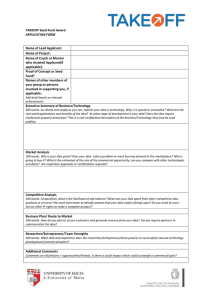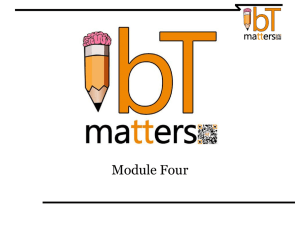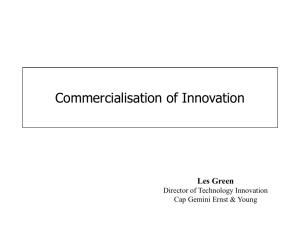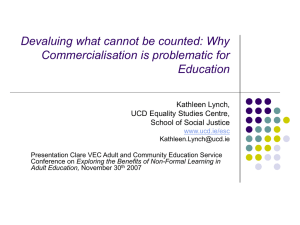Paul O’Reilly, Dublin Institute of Technology
advertisement
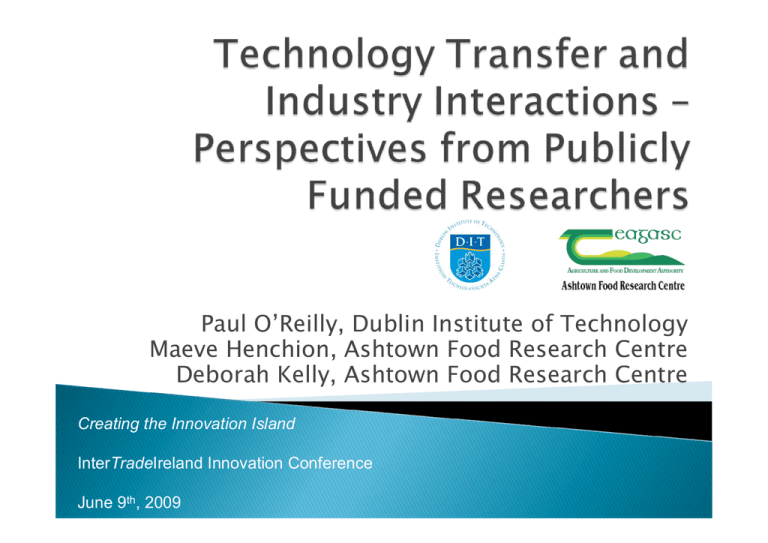
Paul O’Reilly, Dublin Institute of Technology Maeve Henchion, Ashtown Food Research Centre Deborah Kelly, Ashtown Food Research Centre Creating the Innovation Island InterTradeIreland Innovation Conference June 9th, 2009 About TOOLBOX Technology transfer defined Technology transfer prioritised Success and failure factors in technology transfer from publicly funded food research – case study findings Overall TOOLBOX findings TOOLBOX Project ◦ Development of a technology commercialisation toolbox for publicly funded food research Project partners ◦ Dublin Institute of Technology ◦ Ashtown Food Research Centre, Teagasc Funded by Department of Agriculture, Fisheries and Food - Food Institutional Research Measure of the National Development Plan Document and evaluate the existing food innovation system To understand the incentives, barriers and obstacles for successful research commercialisation and technology transfer from the researcher and industry perspectives To identify success and failure factors facilitating research commercialisation and technology transfer in public research projects 4 focus groups Researcher survey Industry survey 20 case studies International best practice case studies 2 workshops Increasing the stock of useful knowledge; Training skilled graduates; Creating new scientific instrumentation and methodologies; Forming networks and stimulating social interaction; Increasing the capacity for scientific and technological problem-solving Provision of social knowledge; and Creating new firms. GENERATING ECONOMIC RETURN FOR CITIZENS Low levels of R&D investment in Irish food industry ◦ Large numbers of SMEs without capability or expertise to invest in R&D ◦ Limited engagement with public research centres Global competition and adverse market conditions Growing interest from policy makers in achieving economic returns from public investment in research Societal benefits (e.g. food safety) Underdeveloped technology transfer functions in public research organisations, Definition: ◦ Technology transfer is the “movement of knowhow, technical knowledge or technology from one organisation to another” (Bozeman, 2000) Rogers et al. (2001): a difficult type of communication process, spanning the stages from R&D to commercialisation. Feller et al (1987): an extended series of “interactive relationships that connect the functional activities of basic research, applied research, development, diffusion, adaptation, and dissemination into an overall technology delivery system”. Levin (1997): socio-technical learning and development process, where the technology is perceived as a social construction where human choice and values influence the result. Autio and Laamanen (1995): Planned, deliberate, goal-oriented relations between two or more persons, groups or organisations to exchange technological knowledge and/or objects and rights. Power and McDougall (2005): Process by which technologies developed in universities are transformed into commercial and marketable products. Building Ireland’s Smart Economy A Framework for Sustainable Economic Renewal December 2008 Department of the Taoiseach “The key objective of Ireland’s Smart Economic Growth framework is to make Ireland the innovation and commercialisation capital of Europe – a country that combines the features of an attractive home for innovative multinationals while also being an incubation environment for the best entrepreneurs from Europe and further afield.” “Ireland has already laid the foundations of the ideas economy by investing heavily in education, skills training and R&D under the National Development Plan, which includes delivery of the Strategy for Science, Technology and Innovation involving major investments in basic research through the PRTLI, SFI and other funding programmes. €8.2 billion has been committed to research, technological development and innovation. Business expenditure on R&D is targeted to grow to about €3.8 billion per annum by 2013.” Industry-led Competence Centre Programme; Active management of Intellectual Property; Implementation of the Strategy for Science, Technology and Innovation (e.g. PRTLI); Promotion of commercialisation of opportunities through relevant funding programmes; Attract to Ireland a premium cohort of world class researchers that will drive up the international visibility; Instil a commercialisation culture in third-level institutions; and Summer schools with an emphasis on innovation and commercialisation. Promoting Enterprise-Higher Education Relationships (Forfás, 2007) ◦ “The two key constraints to the deepening of enterprisehigher education research collaborations in Ireland are the low absorptive capacity of enterprises for research and a gap in the availability of applied research capability that enterprises can readily access. “ ◦ “Research commissioned by the Council indicates that HEIenterprise collaboration operates at a very low level in Ireland, and that the structures for encouragement and support of the process have failed to achieve the level of contribution appropriate to Higher Education Expenditure on Research and Development (HERD)”. European Commission (2005) notes that sub-optimal research collaboration and knowledge transfer between public research organisations and industry are one of the weaknesses of the European research and innovation system that must be overcome if there is to be development of a sustainable knowledge economy. The 1994 White Paper Growth, Competitiveness, Employment. The Challenges and Ways Forward into the 21st Century noted that the “greatest weakness in Europe’s research and industrial base is the comparatively limited capacity to convert scientific breakthroughs and technological achievements into industrial and commercial successes”. 20 case studies ◦ Projects that originated as FIRM funded initiatives ◦ Scientific objectives achieved and validated by multiple peer review publication All cases had technology transfer objectives ◦ 12 cases achieved technology transfer ◦ 8 cases resulted in no identifiable technology transfer Approach ◦ Semi-structured interviews with principal investigators Technology Transfer √ Technology Transfer ╳ Dissemination Person-to-person communications; industry-oriented documentation; ongoing throughout project Reliance on traditional publication; academic audience; end of project; compliance with funding requirements Validation Industry and academic recognition sought; personal motivations Academic recognition sought Research scope Focus on issues of specific enterprise(s) Tendency to focus on industry level issues Performance measurement Will become a barrier in A major deterrent from future investing time working with industry Technology Transfer √ Technology Transfer ╳ Industry relationships “good” “informal and personal” “mutually beneficial” “established” “weak” “formal” “awkward” Frequency of interaction Very frequent; “part of what we do” Limited (by researcher choice) Origin of research ideas Tended to be validated by industry; market demand Researcher own idea from previous research; no evidence of market demand Perspective of industry Considered industry to have incompatible expectations – innovation system must adapt Considered industry to have incompatible expectations – industry must change Motivation of the researcher is critical Overarching importance of personal relationships between researchers and industry Benefits from focusing research efforts around needs of specific enterprise(s) ◦ Aids more regular communications and interaction ◦ Closer relationships ◦ Availability of tacit information Importance of industry buy-in to projects from outset Implications for public research organisations ◦ Significant changes required in researcher performance measurement systems ◦ Need to reconfigure how technology transfer is managed as a process within public research organisations Implications for funding agencies ◦ Potential role for collaborative research programmes Communication : Need for increased and improved communications between researchers and industry. Socialisation: Need to break down boundaries between the public researcher community and the food industry community that inhibit knowledge sharing, collaboration and ultimately technology transfer. Enabling researchers: Need to enhance organisational supports in public science providers to enable technology transfer and industry collaboration. Strategic management: Need for increased strategic management of research project programmes. Industry capabilities: Industry needs to develop capabilities to make strategic use of and leverage publicly funded research, and research organisations need to recognise the diversity of capabilities that exist within the industry. www.dit.ie/toolbox www.dit.ie/toolbox
